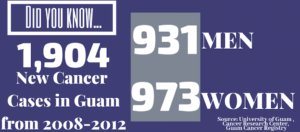Exploring hospice with caregivers and the patient
Jaret Anthony Castro
In 2014, Prevention Education and Community Empowerment shared that diseases of the heart and malignant neoplasms also known as cancer, are the top two causes of death on the island. Aside from my personal experiences with losing someone to cancer. I believe it is important to highlight illnesses like cancer and heart diseases as the leading causes of death in Guam, so the public can become aware and begin making better healthier decisions.

There are many different types of cancer that are circulating our island today. The University of Guam’s Cancer Research Center has explored the vast amount of cancers found in men and women, that range from the breast, prostate, and even colon cancer. I wanted to briefly talk about is breast cancer. The University of Guam’s Cancer Research Center maintains a Guam Cancer Registry.
According to the Guam Cancer Registry, from 2008-2012, there were 292 total breast cancer cases among women and 37 mortality breast cancer cases among women.
According to breastcancer.org, stage four metastasized breast cancer is cancer that has evolved from the breast to different parts of the body like the bones, brain, and other organs.
According to Cancer.org, Hospice Care is meant to provide a more in depth service for the patient and their family is going through the last stages of life before death. They assist with emotional preparation of the family and the patient. Staff from the hospice care department monitor vitals, deliver medicine, and provide overall care for the patient and emotional support for the family.
Experiencing Hospice
Take a minute to imagine your last few weeks or month of your life cooped up in a hospital room without being able to see all of your friends and family because of the limits and guidelines your local hospital sets out for patients. Hospice care is convenient because of the treatment and assistance that you’ll be able to receive in your home. It’s very intimate and calming.
Elizabeth Asuncion, a former caregiver, for Antoinette Castro was able to share more of her experience with caregiving and hospice care. Elizabeth’s sister Antoinette was diagnosed with stage 4 metastasized breast cancer in 2010 and started receiving hospice care in 2016. “We’d come together everyday during the last two weeks she was alive and it was nice to be together in the comfort of her [Antoinette] home,” Asuncion said.
Asuncion explained that throughout her sister’s [Antoinette] experience with hospice, she knew her sister was comfortable. According to Elizabeth, Antoinette was on pain medications for six years.
She would often take Morphine pills and inject herself with Morphine sulfate to help reduce the pain she was experiencing.
During Antoinette’s short time under hospice care, a nurse was able to hook up a machine that injects Antoinette’s body with morphine through her catheter in her chest.
Elizabeth said: “It was so convenient because my sister didn’t have to use a needle and the doses were time. At first we didn’t think it was going to be effective, but after a few doses my sister said it was comforting receiving her pain medication like this than through a shot. She really didn’t like needles.”
Evalyn Sabinay, a medical social work intern from the University of Guam was able to give me an insight about Health Services of the Pacific. Sabinay interned with the company during Fall 2018.
One of the most challenging things Elizabeth faced with caring for her sister was sourcing out medical transportation. When I inquired if HSP offers medical transportation, Sabinay informed me that their ambulance was no longer available.
Sabinay explained that in order for a patient to participate in hospice care, the entire immediate family has to approve of it.
According to Cancer.org, it is common for a representative from hospice to follow up with the patient’s condition throughout the week or daily depending on the severity of the patient’s illness.
In regards to hospice care specifically provided through HSP, Sabinay shared, “Hospice care requires 24/7 around the clock care. Not all families can provide that.” The importance of hospice care involves so much more than checking vital signs and alleviating pain, but being able to assist family members with diaper changes, emotional support, and relieving stress from caregiver burnout.
“At HSP, hospice care also delivers medical equipment, such as oxygen tanks and distribution of Morphine,” Sabinay said.
Hospice care is something that is typically looked at as a sign of death. Although death is often frightening and sad, it is important to remember during the final months of a loved one’s death to prioritize comfort and proper health.
According to the University of Guam, Cancer Research Center, and Cancer Registry, cancer cases and deaths are continuing to grow on the island from 2012, and have increased since, according to the Prevention Education and Community Empowerment.

